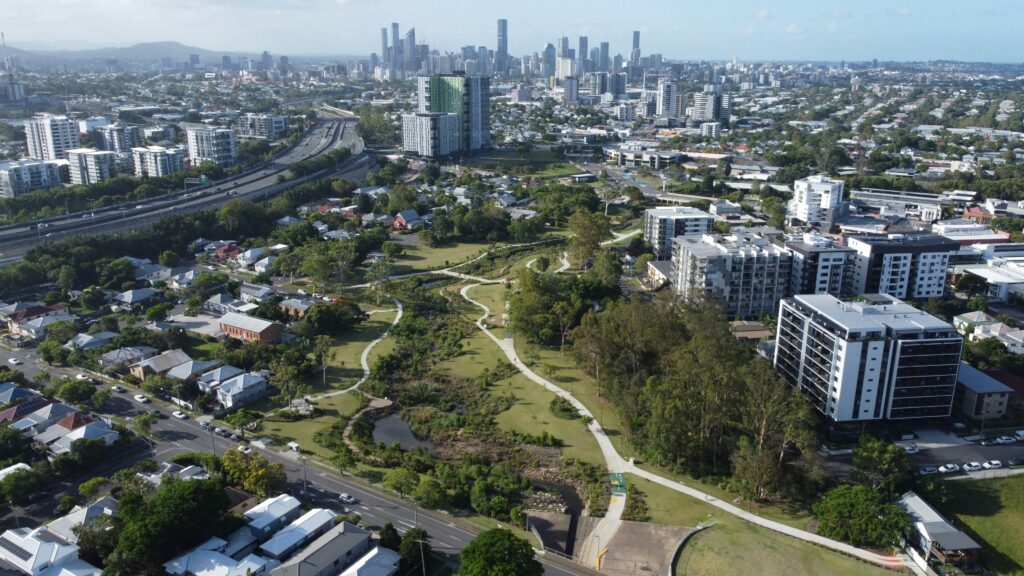
Dr Julie Copley, University of Southern Queensland
Introduction
This blog post argues for greater thoughtfulness about the legal norms of housing when housing security initiatives are being developed by Australian governments.[1]
The contention is that use of new/old thinking about housing — and the security, peace and dignity housing ought to afford each person — would clarify disparities in terminology and understandings of the governments’ role under our Australian legal system, ensuring a sharper and shared focus on the urgent problem of housing insecurity.
Analysis and synthesis of research findings set out below is about, first, terminology and, second, what the law requires.
Budget Speech 2024: A focus on ‘more homes’
In the 2024 Budget Speech, the Federal Treasurer said:
We’re easing the cost of living — and we’re building more homes for Australians.
In the 5 years from this July, we aim to build 1.2 million of them.[2]
A budget day media release from the Federal Housing Minister stated:
The Albanese Labor Government is turbocharging the construction of new homes across the country – building more homes for home buyers, more homes for renters and more homes for Australians in every part of the country. …
The 2024-25 Budget includes $6.2 billion in new investment to build more homes more quickly, bringing the Albanese Government’s new housing initiatives to $32 billion.[3]
The explicit Budget objectives, and the terms used by the Treasurer and Minister, can be compared with language about housing insecurity and homelessness used by Australian people in a human rights context, and the Australian Bureau of Statistics’ reporting of Census data.
First, a 2014 Australian Human Rights Consultation found that a key human rights concern of Australian people is ‘access to affordable housing and homelessness’.[4]
Second, the Australian Bureau of Statistics reports that, at the time of the last Census in 2021:
122,494 people were estimated to be experiencing homelessness on Census night in 2021… 23.0% of all people experiencing homelessness were aged from 12 to 24 years… Aboriginal and/or Torres Strait Islander people [represented] one in five (20.4%) people experiencing homelessness in Australia.[5]
Mismatch in ‘homelessness’ terminology
On the face of it, there is a mismatch in terminology.
On the one hand, the Government announces initiatives for ‘more homes’. On the other, the AHRC identified concerns in response to questions put to people about their human rights (especially ‘property rights’) and reported that people said ‘[t]he right to property provides security, and enables opportunities for economic and social development’.[6]
The ABS data, moreover, is gathered from responses to questions framed according to the ABS statistical definition of ‘homelessness’. The definition is:
when a person does not have suitable accommodation alternatives, they are considered as experiencing homelessness if their current living arrangement: is in a dwelling that is inadequate; has no tenure, or if their initial tenure is short and not extendable, or; does not allow them to have control of, and access to space for social relations.[7]

Empirical and legal definitions of ‘homelessness’
One reason for a mismatch is because a distinction must be drawn between definitions for empirical and legal purposes.
As Christopher Essert (University of Toronto, Faculty of Law) explains, there can be clear differences between a person’s empirical situation and their legal status. Instances of homelessness can be ‘empirically indistinguishable from instances of non-homelessness’; for example, when ‘someone sleeps outside or sleeps in a large room with lots of other people on a mat on the floor and yet does not count [themselves] as homeless’.[8]
Public sector and third sector bodies researching and developing policy rely on an empirical approach as ‘to know who ought to be targeted by such policies, we need to know who counts as homeless.’[9] For these purposes, the ABS statistical definition is adopted commonly in Australia.
However, when law is to be made — and it is important to note here that Budget appropriations are authorised by legislation (law made by parliaments) — a legal rather than an empirical definition is preferable.
Jeremy Waldron, for example, refers to a person who has ‘no place governed by a private property rule where he is allowed to be whenever he chooses, no place governed by a private property rule from which he may or may not at any time be excluded as a result of someone else’s say-so’.[10]
Samuel Tyrer suggests use of the term ‘rooflessness’, affording a wide definition extending to a situation where a person has no physical shelter nor any experience of ‘home’.[11]
Conceptual mismatch: Housing as a commodity vs a human right
A second reason for a mismatch is due to different conceptualisations of the problem and the effectiveness of solutions.
Jessie Hohmann (UTS Faculty of Law) contends Australian governments focus on housing as a commodity rather than on securing, protecting and promoting a human right to housing.[12]
The latter is, in fact, the approach adopted for the ABS statistical definition. It is ‘constructed from a conceptual framework centred around: adequacy of the dwelling; security of tenure in the dwelling, and; control of, and access to space for social relations’.
Ahead of the 2026 Census also, the statistical definition will be reviewed, as recommended by a parliamentary committee, to examine ‘the circumstances in which people living in severely crowded dwellings and boarding houses should be categorised as homeless.’[13]
Note, in this context, the incongruity of the ‘commodity’ in the 2024 Budget: ‘homes’, not houses. The incongruity arises because, as Tyrer explains, ‘the home experience’ comprises three dimensions: ‘(a) the feeling of security; (b) the expression of self-identity; and (c) relationships and family.’
Australia’s international law obligations
The likely reason for a conceptual mismatch, Hohmann argues, is a lack of awareness of what law requires. A set of requirements is stated clearly, however, in an international law obligation Australia adopted nearly half a century ago.
In 1975, the Australian Commonwealth ratified the International Covenant on Economic, Social and Cultural Rights without reservations, and the ICESCR entered into force in Australia in March 1976. Under Art 11(1) of the ICESCR:
the States Parties … recognize the right of everyone to an adequate standard of living for himself and his family, including adequate … housing …
Towards a progressive approach to housing security
So, acting consistently with the ICESCR obligation, Australian governments would not announce spending for ‘more homes’. Australian governments would work progressively to ensure all policies and legislation secure, protect and promote a person’s right to adequate housing.
Nor would the right be given a narrow interpretation: the expert oversight body for the ICESCR (the United Nations Committee on Economic, Social, and Cultural Rights) states that the right demands that each person ‘live somewhere in security, peace and dignity.’[14]
Author

Julie Copley is a Lecturer in Law in the School of Law and Justice at the University of Southern Queensland. She is based at the Ipswich campus.
Julie has significant public and private sector experience working with legislation and in legislative policy. Since 2016, she has been researching and teaching in the School of Law and Justice at UniSQ. In her research and her teaching, Julie encourages others to appreciate legislation as an authoritative source of law and the legislative process as a dignified mode of governance.
[1] Jeremy Waldron, Thoughtfulness and the Rule of Law (Harvard University Press, 2023); Julie Copley, ‘A Right to Adequate Housing: Translating “Political” Rhetoric into Legislation’ (2023) 31 Australian Property Law Journal 71.
[2] Treasury Portfolio, ‘Budget Speech 2024–25, Delivered on 14 May 2024 on the second reading of the Appropriation Bill (No. 1) 2024–25’, available at: <https://ministers.treasury.gov.au/ministers/jim-chalmers-2022/speeches/budget-speech-2024-25>
[3] Ministers for the Department of Social Services, The Hon Julie Collins MP, Minister for Housing, Minister for Homelessness, ‘Homes for Australia Plan: Delivering more homes for Australians – 14 May 2024’.
[4] Australian Human Rights Commission, Rights and Responsibilities: Consultation Report (2015) 39, available at <https://humanrights.gov.au/our-work/rights-and-freedoms/publications/rights-responsibilities-consultation-report>.
[5] Australian Bureau of Statistics, ‘Estimating Homelessness: Census Latest release (Released 22/03/2023)’, available at: < https://www.abs.gov.au/statistics/people/housing/estimating-homelessness-census/latest-release>.
[6] AHRC (n iv).
[7] Australian Bureau of Statistics, ‘4922.0 – Information Paper – A Statistical Definition of Homelessness, 2012’, available at: < https://www.abs.gov.au/AUSSTATS/abs@.nsf/mf/4922.0>.
[8] Christopher Essert, ‘Homelessness as a Legal Phenomenon’ in N Graham, M Davies and L Godden (eds), The Routledge Handbook of Property, Law and Society (Taylor & Francis, 2022) 137–139.
[9] ibid, 138.
[10] Jeremy Waldron, Liberal Rights: Collected Papers 1981–1991 (Cambridge University Press, 1993).
[11] Samuel Tyrer, ‘Home in Australia: Meaning, Values and Law?’ (2020) 43 University of New South Wales Law Journal 340, 341.
[12] Jessie Hohmann, ‘A Right to Housing for the Victorian “Charter of Human Rights and Responsibilities”?: Assessing Potential Models under the “International Covenant on Economic, Social and Cultural Rights”; the “European” Social Charter; and the “South African Constitution”’ (2022) 48 Monash University Law Review 132, 159.
[13] Australian Bureau of Statistics, ‘Estimating Homelessness: Census methodology’, available at: <https://www.abs.gov.au/methodologies/estimating-homelessness-census-methodology/2021>.
[14] Committee on Economic, Social and Cultural Rights (CESCR), General Comment No 4, 6th sess, UN Doc E/1992/23 (13 December 1991) annex III, [7].

Leave a Reply